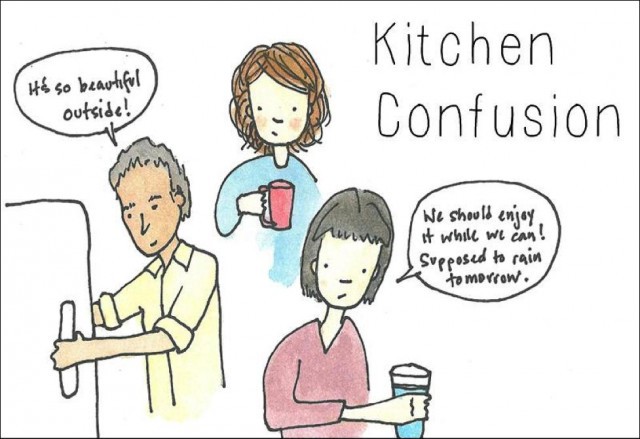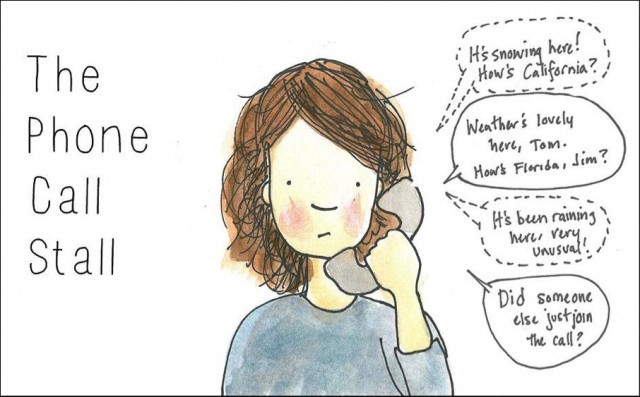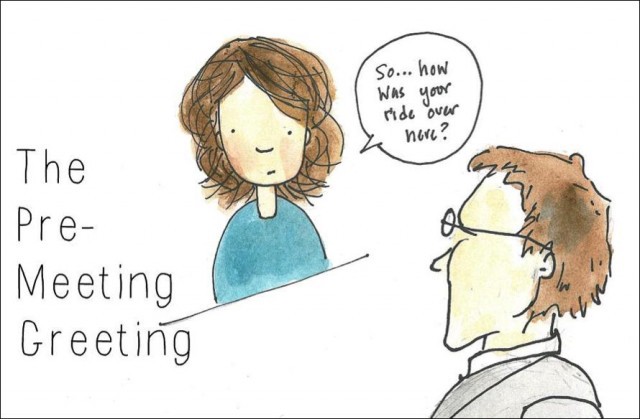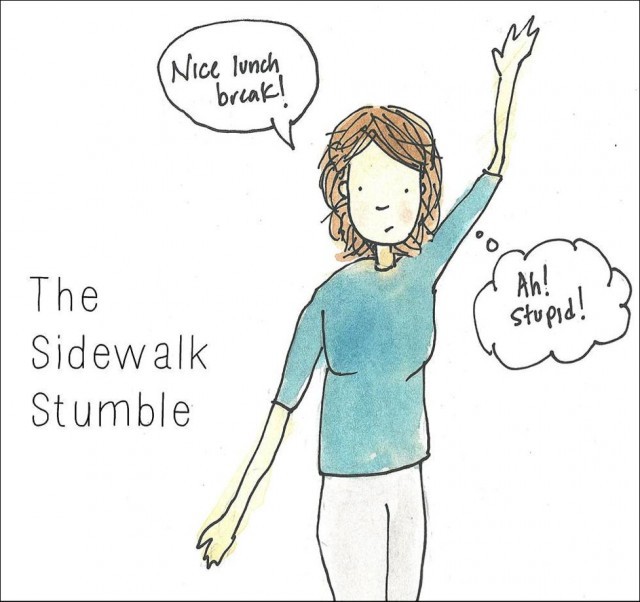Office Small Talk: An Illustrated Typology
by Stephanie Stern
“I’m not sure I like California,” my mom said the last time she was out here to visit me. “You can’t order coffee here without them asking you how your day is going.” She’s a New Yorker. She insisted that her barista didn’t really care how she’s doing, and that this polite inquiry was just wasting her time.
“They are called pleasantries, mom,” I tried to explain. She wasn’t convinced.
My mom’s complaint is not unreasonable. Pleasantries are trite and routine, and, especially in the office environment, they can stress me out. I want a deeper connection with my co-workers, one that goes beyond small talk, yet conversation about the weather or how busy everyone is tends to prevail and is hard to get beyond. I’ve had to recognize that this type of banal exchange is not about the content, but the idea that you are two people that can relate and see each other as individuals.
Catherine Blyth writes in The Art of Conversation: A Guided Tour of a Neglected Pleasure that “anthropologists liken small talk to grooming among primates, largely because it stimulates the snug sense of belonging that makes socializing a joy.” Although anyone can see that it’s a lovely day, “idle comments about weather,” for example, signal that you’re on friendly terms.
I’ve found that categorizing types of small talk helps me let these interactions be what they are, without worrying too much about awkward pauses or lack of depth.
Kitchen Confusion

This is a near daily occurrence: I sneak past the office kitchen holding my empty water glass. I’d intended to go in, but the someone I want to avoid is pouring himself coffee and it’s too early in the morning to try a conversation. Instead, I bide my time in the bathroom, avoiding.
In the kitchen, conversation tends to be very basic (“Good morning, how are you?” or “It’s Friday!”), sometimes getting into food choices (“Your soup looks delicious!”) and the occasional fashion advice or compliment (“Great shoes! So practical!”). I’ve found it helpful to remind myself that the kitchen as a functional space. The mission is to refill coffee mugs or heat up lunch; the socializing is purely a bonus and nothing to let stress me out.
The Phone Call Stall

In a previous job, I had to facilitate monthly board conference calls. They all started in the same awkward way: I would call in and find one or two people on the line, and then we’d compare weather for a few agonizing minutes. Filling in the time before the real meat of the call can start is a skill I don’t have. I always felt relieved when whoever else was expected got on the line and we could finally move on from gems about the weather and start in on the actual agenda.
I’ve realized that one key purpose of this type of small talk is to just try to keep people on the line. I’ve found that chatting prior to the official start of the call keeps others engaged and generally makes for a more productive experience (as anyone who has been on a conference call knows, it’ll all too easy to mute your line and check email or leave to refill coffee while others talk). This can also be a good time to check in about other issues that aren’t on the agenda, or give someone a heads up about an item coming later. I’ve relaxed my standards about filling the time and feel better about weather, work gripes, and even a bit a silence, while we wait.
Pre-Meeting Greeting

Small talk is a preamble to a meeting that affirms that we are people, not just workers. If you have an in-person meeting with someone you’ve never met before, it can be awkward to try to get to know each other before jumping in. Thankfully, being able to see them often means you have much more to work with: vacations, kids, how you broke your wrist on vacation (a recent real life example).
Pre-meeting small talk needs to hit the right balance between acknowledging each other as people and being friendly, without wasting time. If conversation is easy, I enjoy it and it does make me feel more connected to my meeting partners; if not, and I can’t take it anymore, then I just decide it’s time to say, “Ok, let’s get started.”
The Sidewalk Stumble

When escaping my office building to grab lunch or just talk a short walk, I frequently pass a co-worker coming in the opposite direction. This is my most dreaded small talk experience: there is too much time between when you’ve seen the person coming at you and when you actually pass to just say hello. I often end up shouting out inane things like “Such a nice day!” or “Great to get outside!” For me, this is followed immediately by a short internal monologue about how stupid I sound.
The lesson here is that “hello” plus avoiding eye contact is just fine.

Those who are really good at small talk are about pull in interesting, but not overly personal facts, about the people they’re speaking to. I am still an awkward small talker, but having these labels helps me remember that purpose of small talk and to just appreciate it for the pleasantry that it is, rather that scrutinizing the content. I’m still searching for more interesting topics of conversation, but in the meantime, when I say “mmm, coffee!” in the kitchen, I can just shrug to myself and think “kitchen confusion.”
How do you deal with small talk at work?
“The Grindstone” is a series about how we work today by Billfold writers Leda Marritz and Stephanie Stern. Looking for advice? Want to see a specific issue covered in the future? You can email them here.
Steph Stern works in energy and environmental policy in the San Francisco Bay Area. She writes about careers and life choices at Small Answers (or follow on Twitter: @smallanswers).
Support The Billfold
The Billfold continues to exist thanks to support from our readers. Help us continue to do our work by making a monthly pledge on Patreon or a one-time-only contribution through PayPal.
Comments